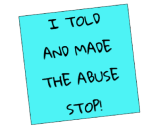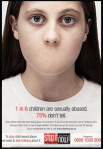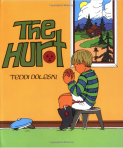by schoolcounselingbyheart | Sep 5, 2012 | abuse, classroom lessons, individual counseling, personal safety
 In the days after a student discloses abuse, I always touch base to see how things are going. I tell them (again) how brave they were and how proud of them I am. Unfortunately, not all of these stories have happy endings, but in many cases, telling helps kids find safety, and they feel protected, empowered, and proud of themselves. Some of the most profoundly moving moments of my career as a school counselor have come when kids have told me about how telling made such a difference in how they are feeling about their situations and about themselves. Here is some of what they have told me (and how I plan to use their words to help other kids too): (more…)
In the days after a student discloses abuse, I always touch base to see how things are going. I tell them (again) how brave they were and how proud of them I am. Unfortunately, not all of these stories have happy endings, but in many cases, telling helps kids find safety, and they feel protected, empowered, and proud of themselves. Some of the most profoundly moving moments of my career as a school counselor have come when kids have told me about how telling made such a difference in how they are feeling about their situations and about themselves. Here is some of what they have told me (and how I plan to use their words to help other kids too): (more…)
by schoolcounselingbyheart | Aug 26, 2012 | abuse, children's literature, classroom lessons, individual counseling, personal safety
 When thinking about perpetrators of child sexual abuse, many people picture an image of a creepy stranger. Parents and schools generally do a pretty good job of teaching their kids about “stranger danger.” But this is not where most of the danger lies. The vast majority of sexual abusers are known to the children they target, so it is incumbent upon us to teach kids not only how to respond when an uncomfortable or dangerous situation arises, but also how to recognize when danger is approaching. (more…)
When thinking about perpetrators of child sexual abuse, many people picture an image of a creepy stranger. Parents and schools generally do a pretty good job of teaching their kids about “stranger danger.” But this is not where most of the danger lies. The vast majority of sexual abusers are known to the children they target, so it is incumbent upon us to teach kids not only how to respond when an uncomfortable or dangerous situation arises, but also how to recognize when danger is approaching. (more…)
by schoolcounselingbyheart | Aug 4, 2012 | abuse, classroom lessons, curriculum, personal safety
 Disclosing sexual abuse is difficult on so many levels. Kids may have been threatened or bribed. They may be worried that the abuse is their fault and that they will get in trouble. They may fear that they won’t be able to live at home any more, that it will cause divorce or the breakup of a parent’s relationship, or that someone they care about will be put in jail. Confusion, shame, and fear are powerful, silencing feelings. And children may just not have the words, know what to say, or how to say it. We need to teach kids the importance of telling, but we also need to teach them how to tell. (more…)
Disclosing sexual abuse is difficult on so many levels. Kids may have been threatened or bribed. They may be worried that the abuse is their fault and that they will get in trouble. They may fear that they won’t be able to live at home any more, that it will cause divorce or the breakup of a parent’s relationship, or that someone they care about will be put in jail. Confusion, shame, and fear are powerful, silencing feelings. And children may just not have the words, know what to say, or how to say it. We need to teach kids the importance of telling, but we also need to teach them how to tell. (more…)
by schoolcounselingbyheart | Jul 29, 2012 | abuse, classroom lessons, curriculum, personal safety
 It was the middle of summer, and all I could think was, “I wish I had all my fifth graders together.” This is not usually the kind of thought I have in July, but three things had happened: Jerry Sandusky had been convicted of sexually abusing ten boys, the NCAA had announced sanctions against Penn State, and a local couple had confessed to sexual assault against a 13-year-old. I knew that many of our students would have seen and heard lots about these incidents, from the media and from adult discussion around them. If school had been in session (more…)
It was the middle of summer, and all I could think was, “I wish I had all my fifth graders together.” This is not usually the kind of thought I have in July, but three things had happened: Jerry Sandusky had been convicted of sexually abusing ten boys, the NCAA had announced sanctions against Penn State, and a local couple had confessed to sexual assault against a 13-year-old. I knew that many of our students would have seen and heard lots about these incidents, from the media and from adult discussion around them. If school had been in session (more…)
by schoolcounselingbyheart | May 31, 2012 | abuse, children's literature, classroom lessons, individual counseling, personal safety
 . . . and I know what to do with it!
. . . and I know what to do with it!
Do You Have a Secret? by Jennifer Moore-Mallinos is a great book about good and bad secrets, how to tell the difference between them, and the importance of telling secrets that make you feel uncomfortable, yucky, or unsafe. I use it — along with my Good Secrets Box and Secret Cards — in first grade class councils and with individual kids in a range of ages. It’s probably best for preschool-grade 2, but older kids sometimes like to read it too. (I love to give older kids books to “review” for younger readers. It helps teach or reinforce concepts and gives struggling (more…)
by schoolcounselingbyheart | Mar 27, 2012 | children's literature, classroom lessons, personal safety
 What happens when you keep your hurt feelings bottled up inside? The hurt deepens and festers. It gets bigger. This is the premise of The Hurt by Teddy Doleski. When Justin gets called a name, he doesn’t tell his friend how he feels or tell his dad what happened. Instead he just sits with his hurt, which looks like a rock, feeding it with his worries and disappointments until it gets so big that it takes up his whole room. The hurt finally starts to shrink and eventually goes away when Justin talks to his dad about it. The Hurt is a great book to share with individuals, in small groups, and in the classroom. It provides (more…)
What happens when you keep your hurt feelings bottled up inside? The hurt deepens and festers. It gets bigger. This is the premise of The Hurt by Teddy Doleski. When Justin gets called a name, he doesn’t tell his friend how he feels or tell his dad what happened. Instead he just sits with his hurt, which looks like a rock, feeding it with his worries and disappointments until it gets so big that it takes up his whole room. The hurt finally starts to shrink and eventually goes away when Justin talks to his dad about it. The Hurt is a great book to share with individuals, in small groups, and in the classroom. It provides (more…)
 In the days after a student discloses abuse, I always touch base to see how things are going. I tell them (again) how brave they were and how proud of them I am. Unfortunately, not all of these stories have happy endings, but in many cases, telling helps kids find safety, and they feel protected, empowered, and proud of themselves. Some of the most profoundly moving moments of my career as a school counselor have come when kids have told me about how telling made such a difference in how they are feeling about their situations and about themselves. Here is some of what they have told me (and how I plan to use their words to help other kids too): (more…)
In the days after a student discloses abuse, I always touch base to see how things are going. I tell them (again) how brave they were and how proud of them I am. Unfortunately, not all of these stories have happy endings, but in many cases, telling helps kids find safety, and they feel protected, empowered, and proud of themselves. Some of the most profoundly moving moments of my career as a school counselor have come when kids have told me about how telling made such a difference in how they are feeling about their situations and about themselves. Here is some of what they have told me (and how I plan to use their words to help other kids too): (more…)




